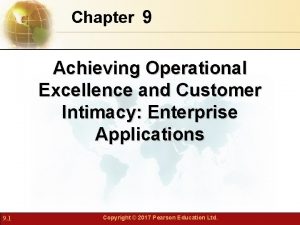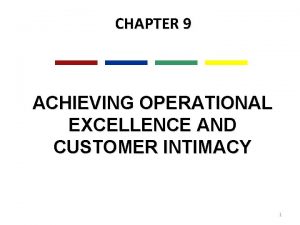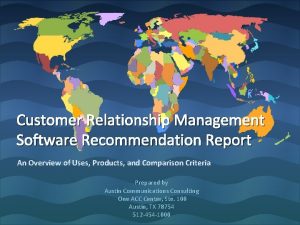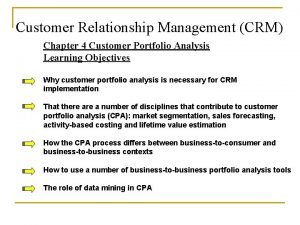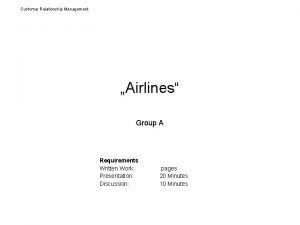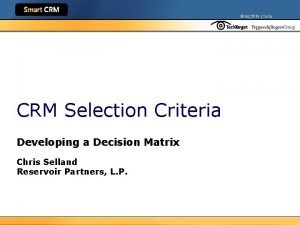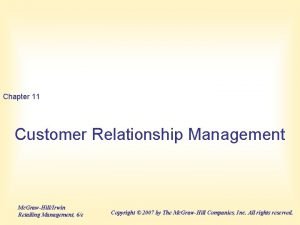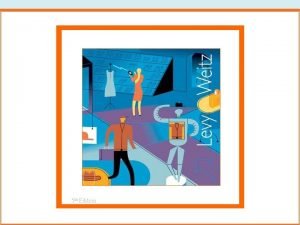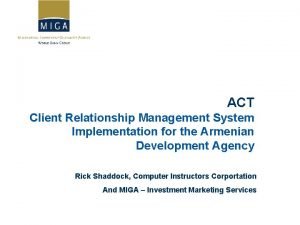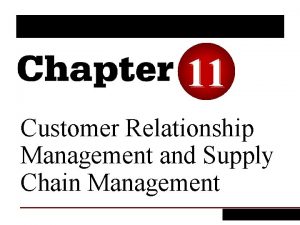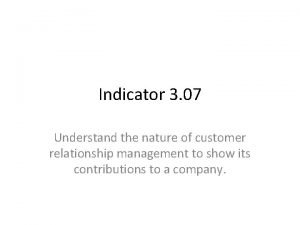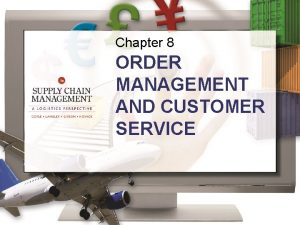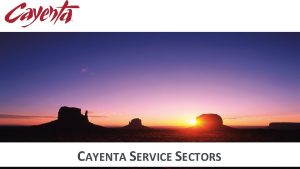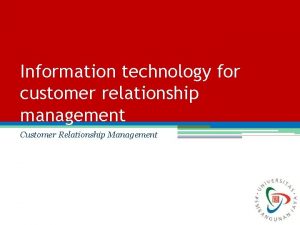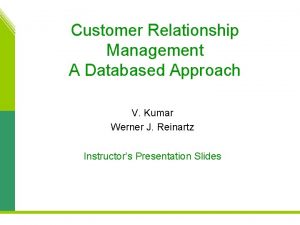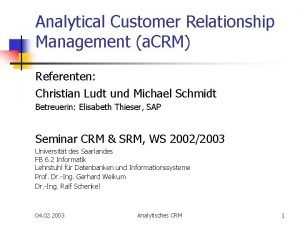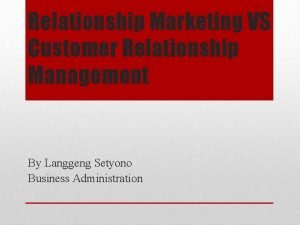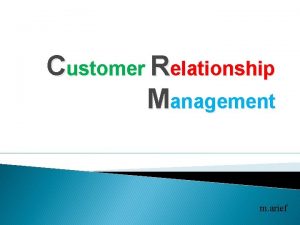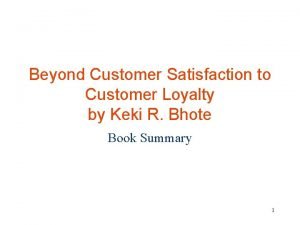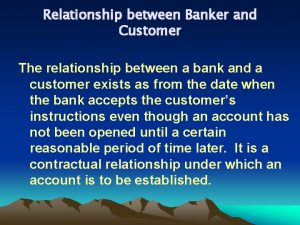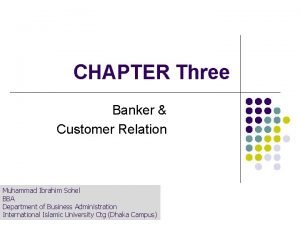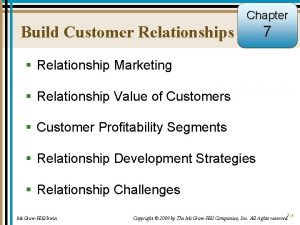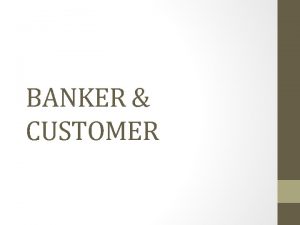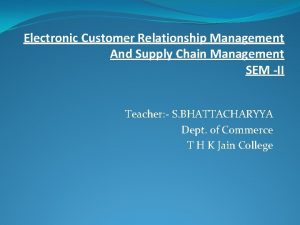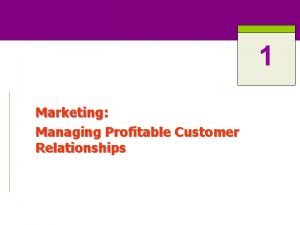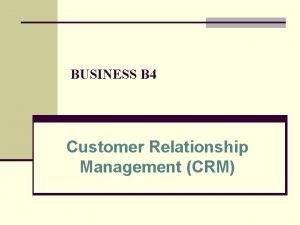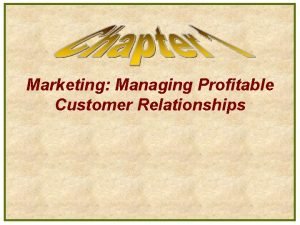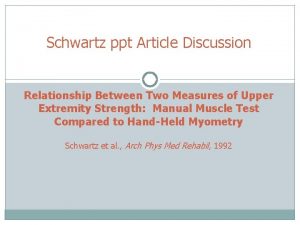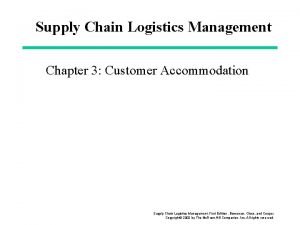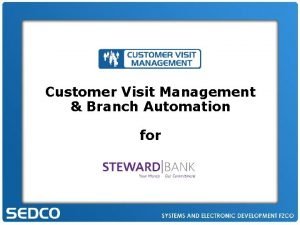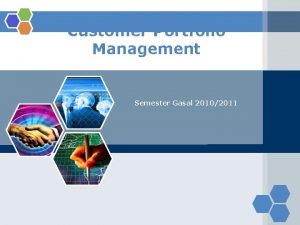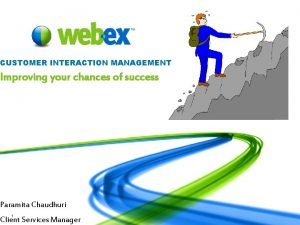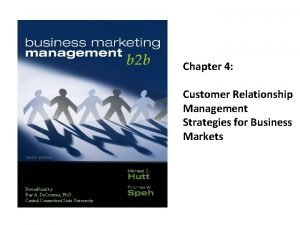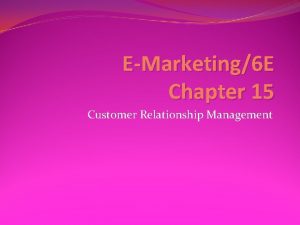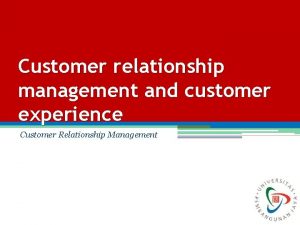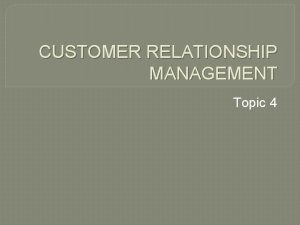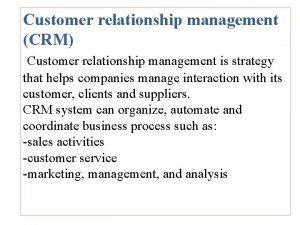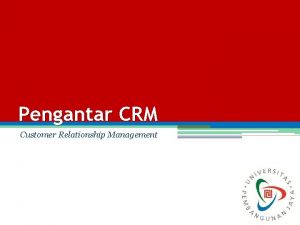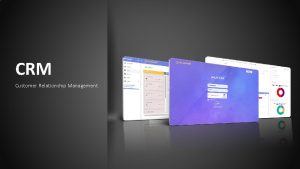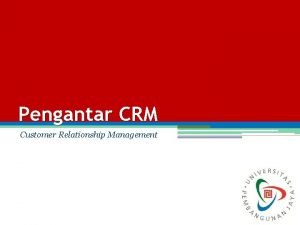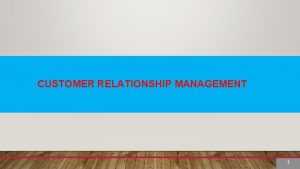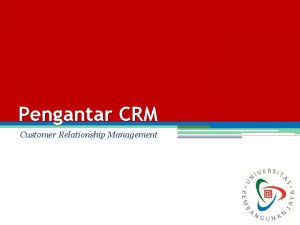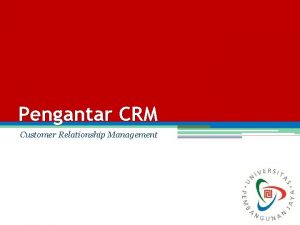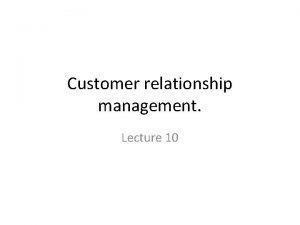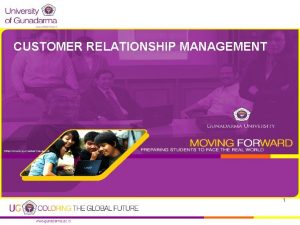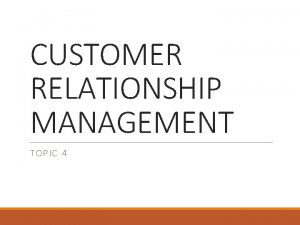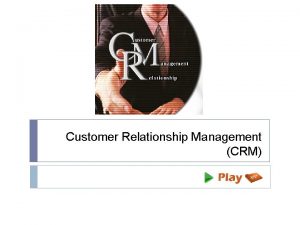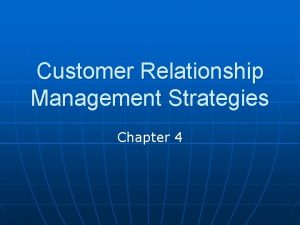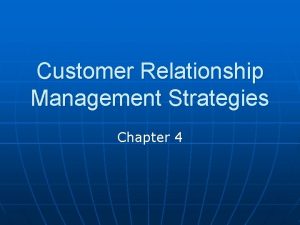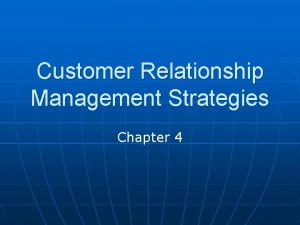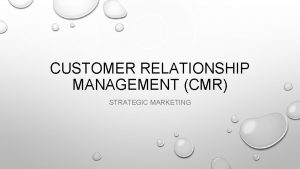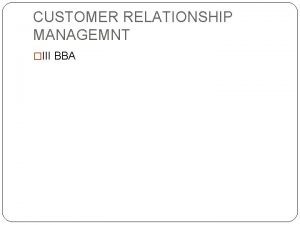EMarketing6 E Chapter 15 Customer Relationship Management Chapter










































- Slides: 42

E-Marketing/6 E Chapter 15 Customer Relationship Management

Chapter 15 Objectives After reading Chapter 15, you will be able to: Define customer relationship management and identify the major benefits to e-marketers. Outline three legs of CRM for e-marketing. Discuss the eight major components needed for effective and efficient CRM in e-marketing. Differentiate between relationship intensity and relationship levels. Highlight some of the company-side and client-side tools that e-marketers use to enhance their CRM processes © 2012 PEARSON EDUCATION, INC. PUBLISHING AS PRENTICE HALL 15 -2

The Cisco Story http: //on. aol. com/video/customer-relationship-management--software-review-193900134 http: //www. youtube. com/watch? v=ie. NGWTVfpe. I Cisco Systems, a $36. 1 billion marketer, provides Internet networking systems for corporate, government, and education clients. The Internet plays a major role in acquiring, retaining, and growing customer business. Over 3 million users log onto the Cisco site each month. Cisco has become expert in online customer relationship management (CRM). © 2012 PEARSON EDUCATION, INC. PUBLISHING AS PRENTICE HALL 15 -3

The Cisco Story, Cont. Cisco set a goal to migrate customers to the online channel. In 1996, 5% of their customers placed orders on the website in 2008, 92. 2% of their orders came through the Internet. Site user satisfaction is 4. 6 on a 5. 0 scale. Can you think of other B 2 B marketers that utilize the Internet as successfully as Cisco? © 2012 PEARSON EDUCATION, INC. PUBLISHING AS PRENTICE HALL 15 -4

Customer Relationship Management http: //www. youtube. com/watch? v=Idmt. JIlk. Hzw © 2012 PEARSON EDUCATION, INC. PUBLISHING AS PRENTICE HALL 15 -5

Building Customer Relationships, 1: 1 According to Harvard Business Review authors Jones and Sasser, “Increased customer loyalty is the single most important driver of long-term performance. ” Many experts believe that relationship capital is the most important asset a firm can have. Major shift in marketing practice Old style was mass marketing New style is individualized marketing Focus on acquiring new customers Retaining and building more business from loyal, high-value customers 1: 1 Consumer Services Market Internet technologies facilitate relationship marketing One key is identifying key Internet tools © 2012 PEARSON EDUCATION, INC. PUBLISHING AS PRENTICE HALL 15 -6

Relationship Marketing Defined Relationship Marketing is about establishing, maintaining, enhancing, and commercializing customer relationships through promise fulfillment. Promise Fulfillment is making offers in their marketing communications programs; customer expectations would be met through actual brand experiences. A firm using relationship marketing focuses more on wallet share than on market share. Wallet share is the amount of sales a firm can generate from one customer Word of mouth Publicity © 2012 PEARSON EDUCATION, INC. PUBLISHING AS PRENTICE HALL 15 -7

FROM MASS MARKETING TO RELATIONSHIP MARKETING © 2012 PEARSON EDUCATION, INC. PUBLISHING AS PRENTICE HALL 15 -8

Stakeholders The four stakeholders most affected by Internet technologies include: Employees who need training and access to data and systems used for relationship management. Business customers in the supply chain. Firms build and maintain relationships with those companies upstream and downstream Both business customers and suppliers are extremely important Lateral partners, such as other businesses, not-for-profit organizations, or governments. Consumers who are end users of products and services. Marketers must differentiate between business customers and final customers © 2012 PEARSON EDUCATION, INC. PUBLISHING AS PRENTICE HALL 15 -9

3 Pillars of Relationship Marketing © 2012 PEARSON EDUCATION, INC. PUBLISHING AS PRENTICE HALL 15 -10

3 Pillars of Relationship Marketing is more than promising fulfillment Two-way communication is vital to the success of this relationship. Cannot define customers without asking who they are Experts believe that relationship marketing has three pillars that support customer relationships with the company’s products and services: Customer Relationship Management (CRM) Customer experience management (CEM) Customer collaboration management (CCM) © 2012 PEARSON EDUCATION, INC. PUBLISHING AS PRENTICE HALL 15 -11

3 Pillars of Relationship Marketing, Cont. Customer Relationship Management (CRM) “The process of targeting, acquiring, transacting, servicing, retaining and building relationships with customer” Customer experience management (CEM) “Represents the discipline, methodology and / or process used to comprehensively manage a customer’s cross-channel exposure, interaction and transaction with a company, product, brand or service” Customer collaboration management (CCM) Also called CRM 2. 0 and Social CRM Paul Greenberg “Social CRM is a philosophy and a business strategy, supported by a technology platform, business rules, workflow, processes and social characteristics, designed to engage the customer in a collaborative conversation in order to provide mutually beneficial value in a trusted and transparent business environment. It's the company's response to the customer's ownership of the conversation”. © 2012 PEARSON EDUCATION, INC. PUBLISHING AS PRENTICE HALL 15 -12

Customer Relationship Management (CRM) Customer experience management (CEM) Definition • The process of targeting… • Discipline, • Social CRM is a methodology and / or philosophy and a process. . . business strategy Focus • Internal processes to • More on the customer • Designed to make the maximize customer expectations and company and the value in the long term touch point customer satisfaction / collaborate to create dissatisfaction mutually beneficial than company aspect results. Requires • • • Controlled by • Marketer Requires much data Information Customer insight Knowledge Requires relationship building skills Customer collaboration management (CCM) / CRM 2. 0 / Social CRM • Experience • Collaboration • Content, people & interaction • Marketer • Customers 15 -13

Customer Relationship Management CRM is a philosophy, strategy, and process that includes all 3 pillars. The benefits of CRM include: Increased revenue from better targeting. Increased wallet share with current customers. Longer retention of customers. More customer leads to more sales Word-of-mouth communication among customers is the heart of CRM Cost Saving The cost of acquiring a new customer is typically 5 times higher than the cost of retaining a current customer. © 2012 PEARSON EDUCATION, INC. PUBLISHING AS PRENTICE HALL 15 -14

9 Building Blocks for Successful CRM 1. 2. 3. 4. 5. 6. 7. 8. 9. CRM vision CRM strategy Customer experience management (CEM) Customer collaboration marketing (CCM) Organizational collaboration CRM processes CRM information CRM technology CRM metrics © 2012 PEARSON EDUCATION, INC. PUBLISHING AS PRENTICE HALL 15 -15

1. CRM Vision To be successful, the CRM vision must start at the top and filter throughout the company to keep the firm customer focused. One key aspect of CRM vision is how to guard customer privacy. The benefits of using customer data must be balanced by the need to satisfy customers and not anger them. TRUSTe provides its seal and logo to any website meeting its privacy philosophies. © 2012 PEARSON EDUCATION, INC. PUBLISHING AS PRENTICE HALL 15 -16

TRUSTe Builds User Trust © 2012 PEARSON EDUCATION, INC. PUBLISHING AS PRENTICE HALL 15 -17

2. CRM Strategy E-marketers must determine their objectives and strategies for initiating CRM programs and buying technology. Relationship Intensity Many CRM goals refer to customer loyalty. Marketers want to move customers up the relationship intensity pyramid (awareness, identity, connection, community, and advocacy). Marketers want to move customers up the relationship intensity pyramid. © 2012 PEARSON EDUCATION, INC. PUBLISHING AS PRENTICE HALL 15 -18

2. CRM Strategy, Cont. Relationship Levels Marketers build a financial bond Use pricing strategies Price promotions are easily imitated Marketers stimulate social interaction with customers Ongoing personal communication Aggressive pricing strategies Customers are more loyal due to the social bond Can also use community building Marketing relies on creating structural solutions to customer problems Firms add value by making structural changes that facilitate the relationship Customizing web pages 15 -19 © 2012 PEARSON EDUCATION, INC. PUBLISHING AS PRENTICE HALL

3. Customer Experience Management Consumers are constantly attacked by marketing communications and unlimited product choices. According to Sheth (1995), the basic principle of CRM is choice reduction. Many consumers are “loyalty prone, ” and will stick with the right product as long as its promises are fulfilled. Synchronous and asynchronous technologies can provide automated and human communications that solve customer problems. Customer Service Permeates ever stage of customer acquisition, retention, and development practices Most often occurs post purchase E-mail and web self-service are emerging trends © 2012 PEARSON EDUCATION, INC. PUBLISHING AS PRENTICE HALL 15 -20

Relationships Over Multiple Communication Channels © 2012 PEARSON EDUCATION, INC. PUBLISHING AS PRENTICE HALL 15 -21

4. Customer Collaboration Management / Marketing (CCM) CCM is content, people, and interaction driven, while traditional CRM is data-driven. CCM is about managing customer relationships and experiences by creating and monitoring online content. Listening is more important than talking when a company is selling. © 2012 PEARSON EDUCATION, INC. PUBLISHING AS PRENTICE HALL 15 -22

5. Organizational Collaboration Marketers collaborate within and outside the organization to focus on customer satisfaction to create a CRM culture. Internally Cross-functional teams focus on customer satisfaction to create a CRM culture Creates a better company culture as well Externally Companies join forces to create results that would reach beyond what each could have done separately. Can be in distribution channel or non-transactional type collaboration © 2012 PEARSON EDUCATION, INC. PUBLISHING AS PRENTICE HALL 15 -23

5. Organizational Collaboration, Cont. CRM-SCM Integration Online retailers can seamlessly link the “backend” (SCM) (e. g. , inventory and payment) with the “front-end” CRM system and the entire supply chain management system (SCM). Extranets, two or more intranet networks that share information, allow CRM-SCM integration. © 2012 PEARSON EDUCATION, INC. PUBLISHING AS PRENTICE HALL 15 -24

CRM-SCM Integration © 2012 PEARSON EDUCATION, INC. PUBLISHING AS PRENTICE HALL 15 -25

6. CRM Processes Firms use specific processes to move customers through the customer care life cycle. © 2012 PEARSON EDUCATION, INC. PUBLISHING AS PRENTICE HALL 15 -26

6. CRM Processes, Cont. Firms monitor and attract customers, both online and offline and they progress through the stages of customer care life cycle. Identifying Customers Firms must obtain prospects Business customers Consumer information Can be categorized as: Highest value, Longest loyalty, Highest frequency of purchase © 2012 PEARSON EDUCATION, INC. PUBLISHING AS PRENTICE HALL 15 -27

6. CRM Processes, Cont. Differentiating Customers The Internet allows firms to collect information to identify various segments. One important way to differentiate – Value 80/20 principle Allows firms to leverage resources by investing in most lucrative customers Firms can identify customers through Data mining Profiling © 2012 PEARSON EDUCATION, INC. PUBLISHING AS PRENTICE HALL 15 -28

6. CRM Processes, Cont. Customizing the Marketing Mix Defined – when firms tailor their marketing mixes to meet the needs of small target segments using electronic marketing tools Customer needs are supreme Firms have data to make customized decisions Firms can zero in on precise needs Personalization – ways that marketers individualize in an impersonal computer networked environment © 2012 PEARSON EDUCATION, INC. PUBLISHING AS PRENTICE HALL 15 -29

6. CRM Processes, Cont. Interaction Allows firms to collect the data necessary for identification and differentiation Allows firms to evaluate the resulting customization effectiveness. Both the firm and the customer learn from each experience and interaction © 2012 PEARSON EDUCATION, INC. PUBLISHING AS PRENTICE HALL 15 -30

CRM Churn Reduction Cycle © 2012 PEARSON EDUCATION, INC. PUBLISHING AS PRENTICE HALL 15 -31

Sales Force Automation (SFA) Sales force automation allows salespeople to build, maintain, and access customer records, manage leads, and manage their schedules. Up-to-date customer and prospect records help build customer relationships. © 2012 PEARSON EDUCATION, INC. PUBLISHING AS PRENTICE HALL 15 -32

Marketing Automation Marketing automation activities help provide: Effective targeting. Efficient marketing communication. Real-time monitoring of customer and market trends. SAS, a business intelligence and predictive analytics software provider, offers automation to aid marketers. © 2012 PEARSON EDUCATION, INC. PUBLISHING AS PRENTICE HALL 15 -33

7. CRM Information The more information a firm has, the better value (more accurate, timely, and relevant information) it can provide to each current or prospective customer. Firms gain much information by tracking behavior electronically. Bar code scanner data. Software that tracks online movement, time spent per page, and purchase behavior. © 2012 PEARSON EDUCATION, INC. PUBLISHING AS PRENTICE HALL 15 -34

7. CRM Information, Cont. Some factors in facilitating customer relationship management are: Target the right customers Own the customer’s total experience Streamline business processes that impact the customer Provide a 360 degree view of the customer relationship Let customers help themselves Help customers do their jobs Deliver personalized service Foster community © 2012 PEARSON EDUCATION, INC. PUBLISHING AS PRENTICE HALL 15 -35

8. CRM Technology The Internet forms the centerpiece of a firm’s CRM abilities. Cookies, web logs, bar code scanners help to collect information about consumers and their behaviors. Firms use company-side tools to push customized information to users. Client-side tools allow the customer to pull information; that initiates the customized response; from the firm. © 2012 PEARSON EDUCATION, INC. PUBLISHING AS PRENTICE HALL 15 -36

Company-Side Tools (push) © 2012 PEARSON EDUCATION, INC. PUBLISHING AS PRENTICE HALL 15 -37

Client-Side Tools (pull) © 2012 PEARSON EDUCATION, INC. PUBLISHING AS PRENTICE HALL 15 -38

Top Types of CRM-Related Software © 2012 PEARSON EDUCATION, INC. PUBLISHING AS PRENTICE HALL 15 -39

9. CRM Metrics E-marketers use numerous metrics to assess the Internet’s value in delivering CRM performance. Experts believe three most important metrics to CRM are customer retention rates, ROI, and customer lift (increased response or transaction rates). ROI Cost savings Revenues Customer satisfaction Customer Lifetime Value (LTV) Contribution of each CRM tactic to these measures © 2012 PEARSON EDUCATION, INC. PUBLISHING AS PRENTICE HALL 15 -40

10 RULES FOR CRM SUCCESS 1. 2. 3. 4. 5. 6. 7. 8. 9. 10. Recognize the customer’s role. Build a business case. Gain buy-in from end users to executives. Make every contact count. Drive sales effectiveness. Measure and manage the marketing return. Leverage the loyalty effect. Choose the right tools and approach. Build the team. Seek outside help. © 2012 PEARSON EDUCATION, INC. PUBLISHING AS PRENTICE HALL 15 -41

All rights reserved. No part of this publication may be reproduced, stored in a retrieval system, or transmitted, in any form or by any means, electronic, mechanical, photocopying, recording, or otherwise, without the prior written permission of the publisher. Printed in the United States of America. Copyright © 2012 Pearson Education, Inc. Publishing as Prentice Hall 15 -42
 Customer relationship management and customer intimacy
Customer relationship management and customer intimacy Customer relationship management and customer intimacy
Customer relationship management and customer intimacy Intimacy
Intimacy Ecrm features
Ecrm features Recommendation of customer relationship management
Recommendation of customer relationship management Customer relationship management training ppt
Customer relationship management training ppt Portfolio management crm
Portfolio management crm Airline customer relationship management
Airline customer relationship management Crm software selection criteria
Crm software selection criteria Crm process in retailing
Crm process in retailing Crm in marketing ppt
Crm in marketing ppt Act client database
Act client database Customer relationship management in supply chain
Customer relationship management in supply chain Nature of customer relationship management
Nature of customer relationship management Order management & customer service relationship concept
Order management & customer service relationship concept Cayenta general ledger
Cayenta general ledger Crm and information technology
Crm and information technology Rfm
Rfm Kundenverhaltensanalyse
Kundenverhaltensanalyse Sugar customer relationship management
Sugar customer relationship management Difference between rm and crm
Difference between rm and crm Using marketing information to gain customer insights
Using marketing information to gain customer insights Pengertian customer relationship
Pengertian customer relationship Beyond customer satisfaction
Beyond customer satisfaction Contract between banker and customer
Contract between banker and customer Relationship between banker and customer
Relationship between banker and customer Define the relationship chapter 7
Define the relationship chapter 7 Relation between banker and customer
Relation between banker and customer Special relationship between banker and customer
Special relationship between banker and customer Phases of ecrm
Phases of ecrm Is managing profitable customer relationship
Is managing profitable customer relationship Involves managing all aspects of a customer relationship
Involves managing all aspects of a customer relationship Key suppliers business model canvas
Key suppliers business model canvas Customer relationship matrix
Customer relationship matrix Relationship between banker and customer ppt
Relationship between banker and customer ppt Customer accommodation
Customer accommodation Branch automation solutions
Branch automation solutions Contoh portofolio pelanggan
Contoh portofolio pelanggan Define customer portfolio management
Define customer portfolio management Customer interaction management
Customer interaction management Customer experience management maturity model
Customer experience management maturity model Customer experience management conference 2010
Customer experience management conference 2010 Transactional exchange
Transactional exchange

